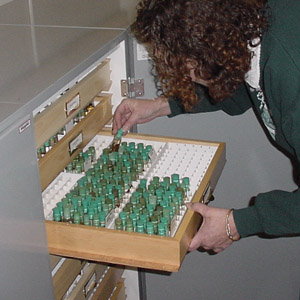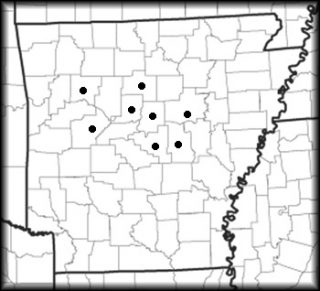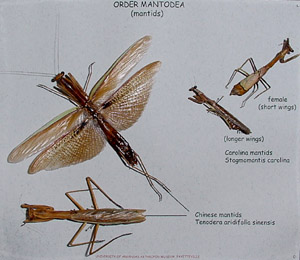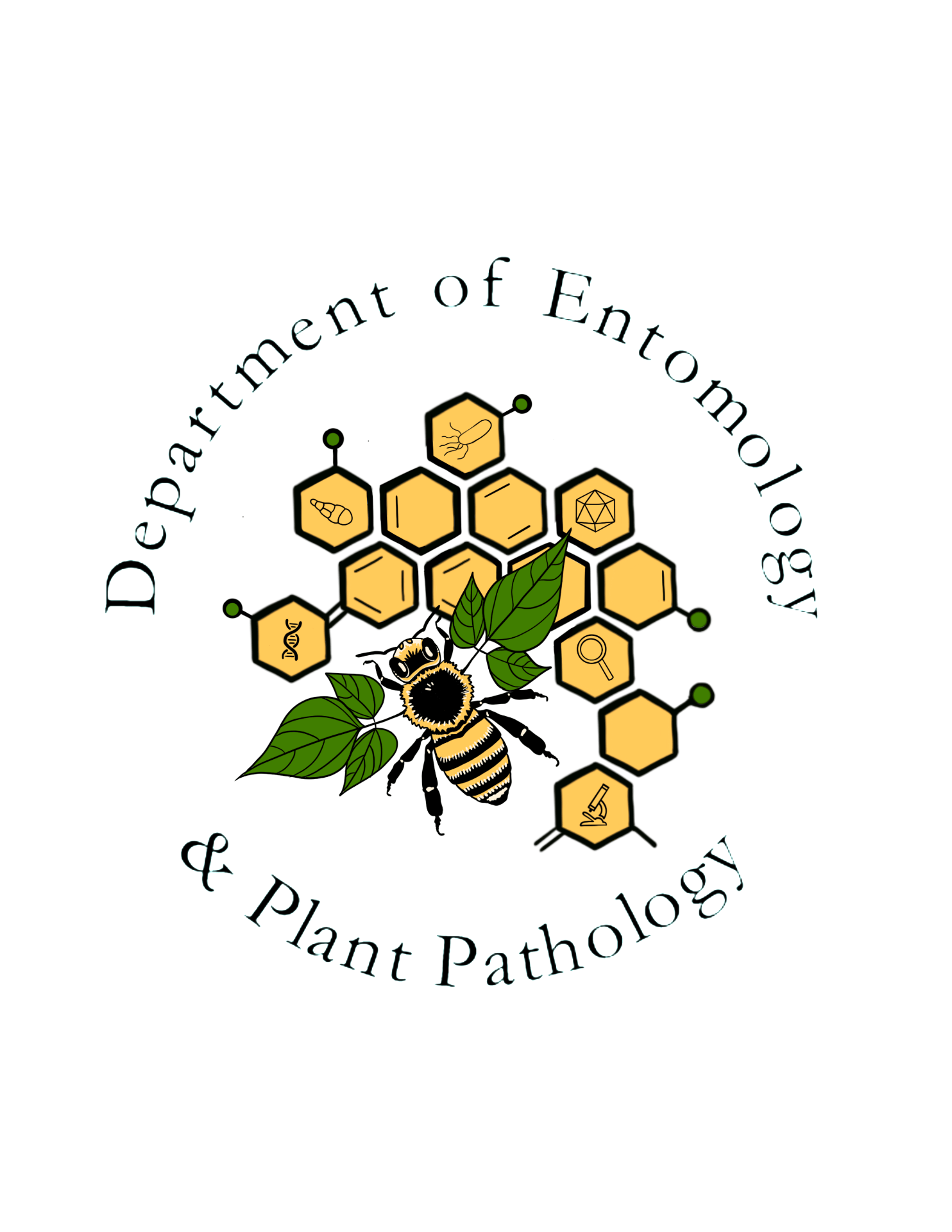Arthropod Museum Overview
Introduction
Arthropods are the earth’s most diverse organisms. Over 60% of all known species, both plant and animal, are arthropods (insects, spiders, mites, crustaceans, and related groups). The insects account for over half of all species described thus far, and they are the dominant form of life in terrestrial environments. There are perhaps 35,000 or 40,000 known species of arthropods recorded from Arkansas, and it is still not uncommon to find species here that are unnamed and new to the scientific world.
Pest arthropods cause harm to man and his structures, crops, and livestock, while beneficial species pollinate crops, prey upon pestiferous forms, or serve as food for wildlife. In an environmentally conscious society, arthropods are regarded as essential components of our ecosystems. Knowing the name of an arthropod is the key to unlocking the store of accumulated knowledge about its life history, distribution, and relationships to man. Unfortunately, most arthropods are not easily identified to species level by the general student, or even by trained, professional entomologists. Even the most dedicated insect taxonomy specialists find it difficult, and sometimes impossible, to identify some species they encounter.
Museum Facilities and Staff
 The University of Arkansas System Division of Agriculture Arthropod Museum houses the largest collection of insects and other arthropods in the State of Arkansas and one of the largest collections of arthropods from the faunistically unique Ozark Plateau and Ouachita Highlands, with especially significant collections of Ozark cave arthropods and Arkansas spiders. The Museum houses an estimated 750,000 specimens, representing perhaps 25,000 of Arkansas’ estimated 40,000 arthropod species. The Museum is located at 1580 Mitchell Street in Fayetteville, Arkansas. Dried, pinned specimens are stored in 1800 standard “Cornell style” glass-top wooden entomology drawers, which in turn are held in fourteen 12-drawer metal cases and sixty-six 25-drawer metal cases. Up to 1994, most of the pinned collection was housed in outdated, over-sized wooden vial collection cabinets and poorly constructed, warped wooden “kit” drawers that offered inadequate protection
The University of Arkansas System Division of Agriculture Arthropod Museum houses the largest collection of insects and other arthropods in the State of Arkansas and one of the largest collections of arthropods from the faunistically unique Ozark Plateau and Ouachita Highlands, with especially significant collections of Ozark cave arthropods and Arkansas spiders. The Museum houses an estimated 750,000 specimens, representing perhaps 25,000 of Arkansas’ estimated 40,000 arthropod species. The Museum is located at 1580 Mitchell Street in Fayetteville, Arkansas. Dried, pinned specimens are stored in 1800 standard “Cornell style” glass-top wooden entomology drawers, which in turn are held in fourteen 12-drawer metal cases and sixty-six 25-drawer metal cases. Up to 1994, most of the pinned collection was housed in outdated, over-sized wooden vial collection cabinets and poorly constructed, warped wooden “kit” drawers that offered inadequate protection  and preservation and made inefficient use of space. That year, a National Science Foundation grant provided over $50,000 for replacement of many of the old cabinets and provided temporary additional curatorial assistance during the collection’s reorganization into new cabinets. Up to 2005, a hodgepodge of office file cases housed alcohol-preserved specimens in glass vials, many of which could not be easily accessed for study. Seven modern vial cases were crammed to capacity making collection expansion impossible. In that year, the Arkansas Agricultural Experiment Station provided $52,920 for collection improvement. Over 40% of the old Cornell drawers have been replaced with new pest-resistant drawers, the vial collection is now housed in 15 modern 3000-vial cases with plenty of room to expand, and the Museum now features an expanded 42” deep curator’s work bench.
and preservation and made inefficient use of space. That year, a National Science Foundation grant provided over $50,000 for replacement of many of the old cabinets and provided temporary additional curatorial assistance during the collection’s reorganization into new cabinets. Up to 2005, a hodgepodge of office file cases housed alcohol-preserved specimens in glass vials, many of which could not be easily accessed for study. Seven modern vial cases were crammed to capacity making collection expansion impossible. In that year, the Arkansas Agricultural Experiment Station provided $52,920 for collection improvement. Over 40% of the old Cornell drawers have been replaced with new pest-resistant drawers, the vial collection is now housed in 15 modern 3000-vial cases with plenty of room to expand, and the Museum now features an expanded 42” deep curator’s work bench.
Museum specimens in all groups of arthropods are professionally identified using specialized techniques, equipment, and literature; they are therefore priceless reference resources for comparison with unknown specimens. A full-time Curator, who reports to the Head of the Department of Entomology, staffs the Museum. He maintains and develops the Museum collections; handles identification, information, and loan requests; directs the Museum’s public programs; maintains the Museum’s website; teaches courses in insect taxonomy; and conducts research on the insect fauna of Arkansas. He provides identification and information services for the Arkansas Agricultural Experiment Station, extension personnel, natural resource agencies, other state and federal agencies, institutions of learning, industry, and the general public. The Department Secretary is trained in Museum procedures and provides part-time help with Museum maintenance.  An extensive literature collection is at hand to facilitate timely arthropod identification, and all supplies and equipment necessary for insect collecting, mounting and curation are in stock. The Museum is adequately equipped with new or relatively new computers, dissecting microscopes, a relatively new phase contrast microscope, and digital cameras.The Museum also houses an AutoMontage photomicrography system, which can be used in conjunction with the phase contrast microscope or the stereoscope to which it is usually attached.
An extensive literature collection is at hand to facilitate timely arthropod identification, and all supplies and equipment necessary for insect collecting, mounting and curation are in stock. The Museum is adequately equipped with new or relatively new computers, dissecting microscopes, a relatively new phase contrast microscope, and digital cameras.The Museum also houses an AutoMontage photomicrography system, which can be used in conjunction with the phase contrast microscope or the stereoscope to which it is usually attached.
Outreach and Impact
The Museum’s collection serves as the major reference resource for arthropod identifications in the State of Arkansas. With the aid of the specimens and associated literature collections, the Curator annually provides hundreds of reliable, professional arthropod specimen identifications and information services. These services assist researchers, government agencies, businesses, and individuals in their efforts to control insect pest problems and protect the environment.
 The museum is listed and described in the most recent compilations of world insect collections, and the worldwide arthropod systematics community uses the collection for taxonomic research purposes. Label data associated with specimens in the Museum record when and where species occur in the state. These data are used in charting species distribution and tracking the health of species of conservation concern.
The museum is listed and described in the most recent compilations of world insect collections, and the worldwide arthropod systematics community uses the collection for taxonomic research purposes. Label data associated with specimens in the Museum record when and where species occur in the state. These data are used in charting species distribution and tracking the health of species of conservation concern.
 Each year, Museum specimens are displayed at various venues, giving upwards of 10,000 citizens some exposure to the world of insects. A small percentage of the pinned collection (36 drawers) is prepared for exhibition by appointment. Exhibit drawers are brought out for pre-arranged museum tours, special programs, and school visits, which are conducted by Department graduate students. This Museum website reaches out to researchers with a bibliography of Arkansas arthropod biodiversity, and it reaches out to extension specialists and the general public with a series of illustrated popular articles on important and interesting regional species. Museum resources also are essential to the success of courses such as insect taxonomy.
Each year, Museum specimens are displayed at various venues, giving upwards of 10,000 citizens some exposure to the world of insects. A small percentage of the pinned collection (36 drawers) is prepared for exhibition by appointment. Exhibit drawers are brought out for pre-arranged museum tours, special programs, and school visits, which are conducted by Department graduate students. This Museum website reaches out to researchers with a bibliography of Arkansas arthropod biodiversity, and it reaches out to extension specialists and the general public with a series of illustrated popular articles on important and interesting regional species. Museum resources also are essential to the success of courses such as insect taxonomy.
